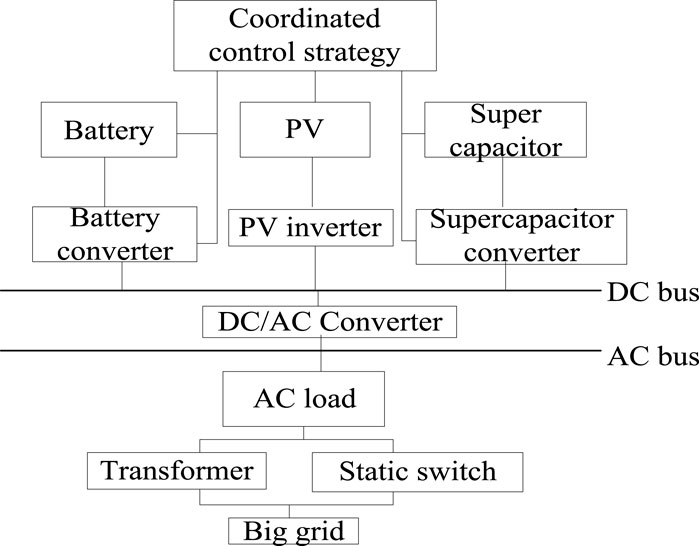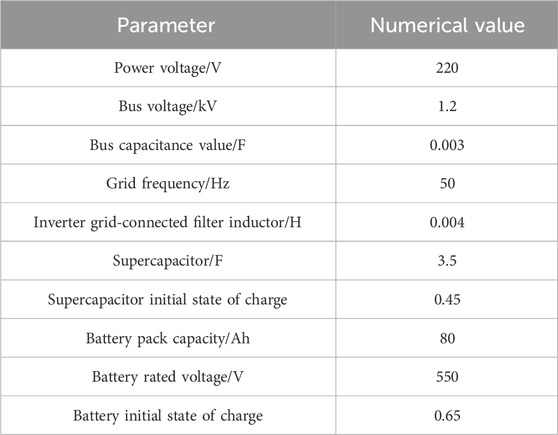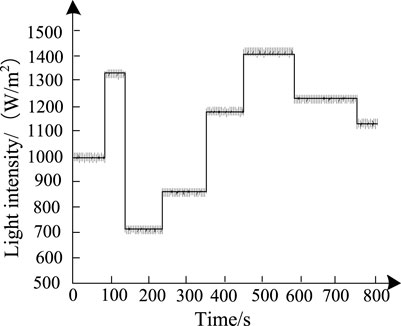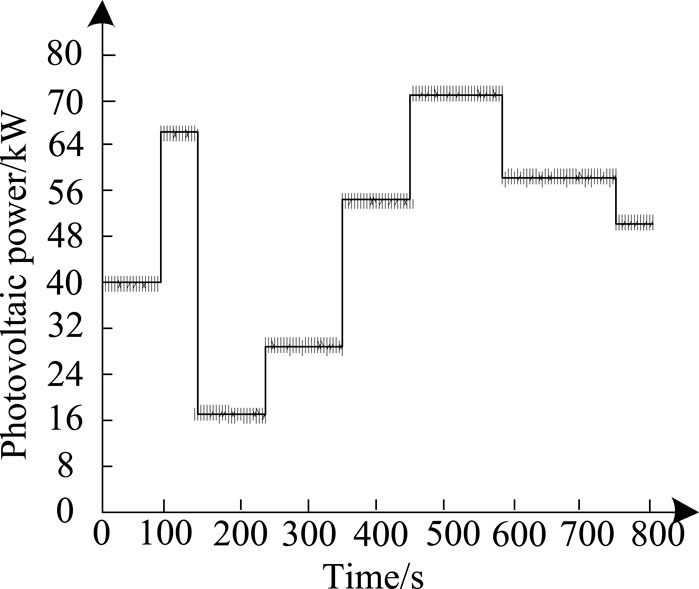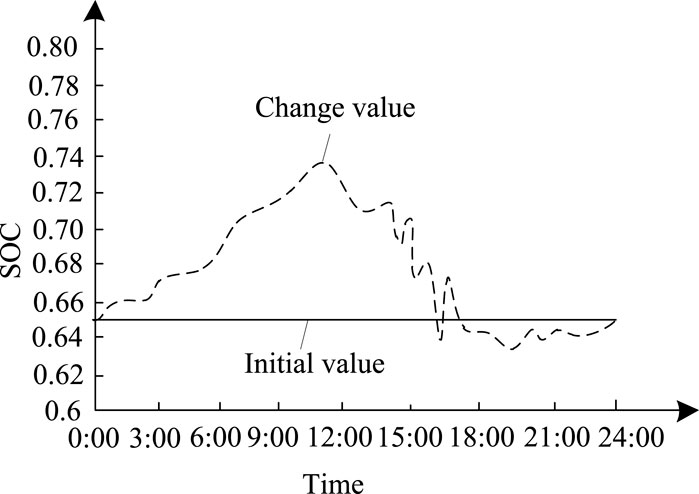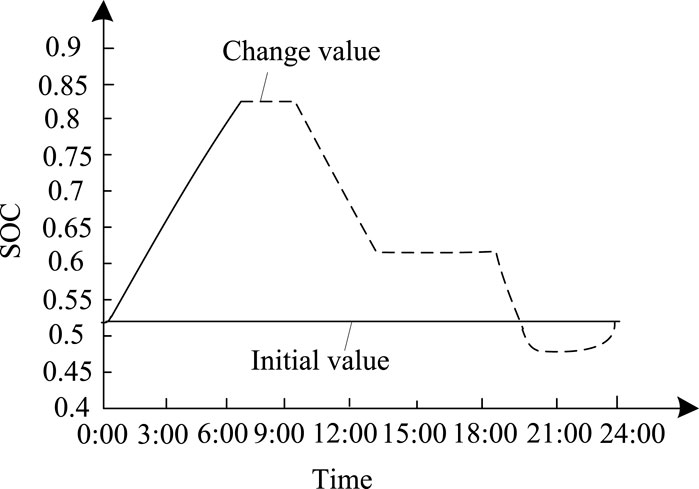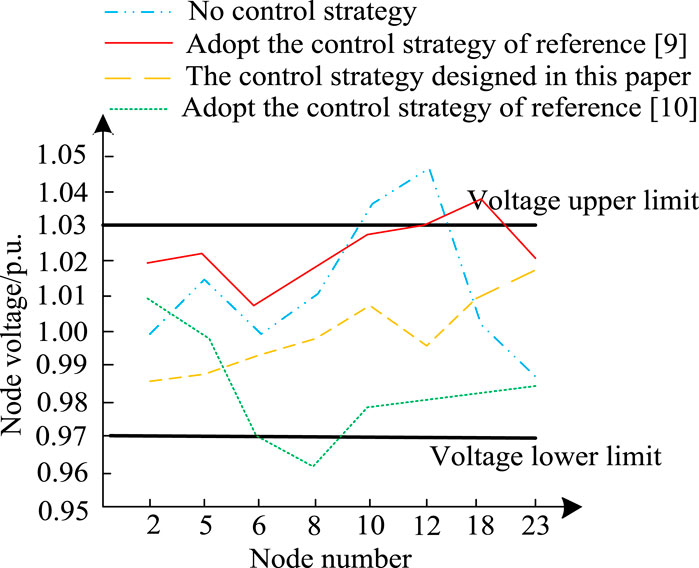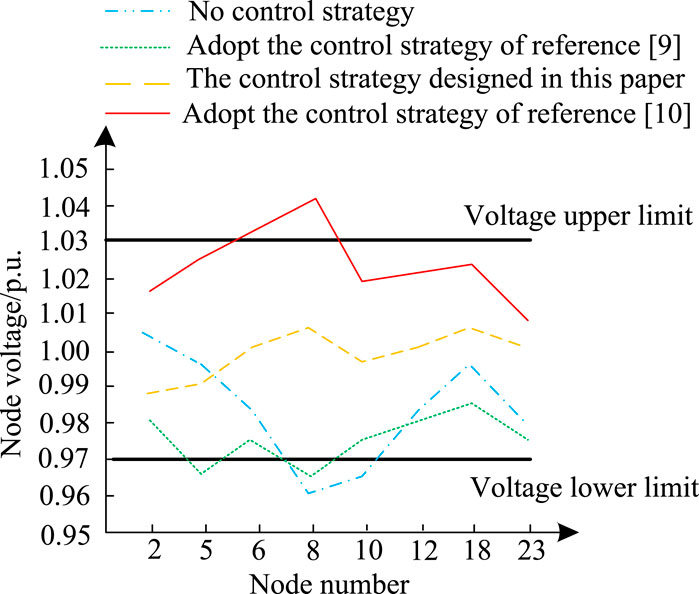- State Grid Henan Electric Power Company Luohe Electric Power Supply Company, Luohe, China
In order to solve the problem of variable steady-state operation nodes and poor coordination control effect in photovoltaic energy storage plants, the coordination control strategy of photovoltaic energy storage plants based on ADP is studied. Establish the photovoltaic energy storage power station model including photovoltaic system model, super capacitor system model and battery system model; Set the maximum limit of active power change as the power constraint condition for coordinated control of photovoltaic energy storage station; The optimal control problem of multi voltage and reactive power resource coordination is fully considered, the optimal voltage control model is established by using ADP algorithm, and the optimal coordinated control strategy is obtained by online learning the collected dynamic operation information. The experimental results show that this strategy can improve the coordinated control effect of the photovoltaic energy storage station, ensure the photovoltaic energy storage station in a stable operation state, improve the service life of the energy storage device in the photovoltaic energy storage station, and stabilize the steady-state operating node voltage within the ideal fluctuation range.
1 Introduction
Environmental problem is the main problem that our country society faces at present, energy shortage problem is the important problem that our country electric power domain faces. The use of clean energy is an important way to improve energy scarcity (Xiao et al., 2020). Solar energy is an important energy in clean energy. Solar energy has the characteristics of high safety and abundant reserves. The application of Solar energy in power system can effectively improve environmental problems and energy crisis (Liu et al., 2020). Photovoltaic power generation system using solar energy as clean energy has the characteristics of high randomness and intermittence, and photovoltaic output randomness and intermittence are high (Tang et al., 2020). In order to ensure the stable and reliable power supply of photovoltaic power generation systems, photovoltaic power generation systems shall be equipped with energy storage systems to store sufficient energy, and photovoltaic power storage systems shall be used to ensure the efficient operation of photovoltaic power generation systems.
The fluctuation of photovoltaic output in photovoltaic storage power station affects the security and economy of power system. In photovoltaic energy storage power plants, there exist the problems of variable steady-state operation points and incomplete or inaccurate information of power system parameters (Dong XW. et al., 2021). In order to solve the above problems in photovoltaic storage power plants, high-performance coordinated control strategy is very important (Zhang et al., 2020).
At present, there are many researches on photovoltaic power grid coordinated control. Lu Jinling and others put forward the coordinated control strategy for hybrid photovoltaic power grid (Lu et al., 2021). The filter control model is constructed to distribute power. According to the charged state, the working state of the energy storage converter is controlled and the charging and discharging or idle mode is switched in time. The improved variable step size disturbance observation method is used to coordinate the stable operation of the control system. Cui Hongfen et al. studied coordinated control strategies for a wind-based storage grid (Cui et al., 2020). The black-start control model of storage power station is established, and the coordinated control strategy of unit load tracking power is designed. When the output is enough, the unit can reduce the charging power according to the power change. Srilakshmi K and others connect to the DC bus using a three-level parallel voltage source converter (VSC). The Jaya gray wolf hybrid algorithm (GWJA) was used to optimize the gain values of the fractional order proportional integral differential controller (FOPIDC) and the parameter values of the HAPF. Satisfactory performance has been achieved under different load combinations such as electric vehicle charging loads, nonlinear loads, and solar irradiation conditions (Srilakshmi et al., 2024a). Srilakshmi K and Gaddamedechi Sdengen et al. designed a Unified Power Quality Controller (UPQC) by using the Enhanced Most Valuable Player Algorithm (EMVPA) to optimize the selection of active filters and PID controller (PIDC) parameters. This integration helps to achieve reliable power supply, efficient utilization of power generation, and effective demand satisfaction, achieving appropriate and effective power sharing (Srilakshmi et al., 2024b). Srilakshmi K and Rao G S et al. used Levenberg Marquardt (LM) backpropagation (LMBP) trained artificial neural network control (ANNC) technology to generate reference signals for converters in UPQC. A hybrid algorithm (FFHSA) combining Harmony Search Algorithm (HSA) and Firefly Algorithm (FFA) has been implemented for optimizing the selection of parameters in Adaptive Neural Fuzzy Interface System (ANFIS) to maintain a constant DC link capacitor voltage (DLCV) (Srilakshmi et al., 2024c). These methods can coordinate the control of photovoltaic power grid, but the effect of coordination control is poor because of over-dependence on parameter information and failure to consider the variable steady-state operating points.
The smooth control algorithm considering ADP is selected as the coordinated control strategy of photovoltaic energy storage plants, which can adjust the output power instability of photovoltaic power plants to meet the photovoltaic grid-connected conditions.
So in order to improve the coordination control effect of photovoltaic energy storage plant, this paper studies the coordination control strategy of photovoltaic energy storage plant based on ADP. The optimal energy storage power of photovoltaic energy storage power station is obtained based on the real-time data such as the charge state of the storage system. This paper constructs an optimal voltage control model through ADP algorithm and obtains the optimal coordinated control strategy. The experimental results show that the proposed strategy can improve the coordination control effect of the PV(Photovoltaic) storage plant, meet the demand of the PV storage plant’s charging and discharging power.
The contributions of this abstract are as follows.
(1) Optimize steady-state operation nodes. By using the ADP algorithm, real-time learning of dynamic operation information of the power plant can be achieved, and control strategies can be adjusted accordingly to ensure that the photovoltaic energy storage power plant can operate stably in the ideal state.
(2) Improving the effectiveness of coordinated control. Traditional coordinated control methods often struggle to cope with the complex and ever-changing operating conditions inside photovoltaic energy storage stations. This article ensures the rationality and effectiveness of the control strategy by setting the maximum limit of active power variation as a power constraint condition. At the same time, the coordinated control problem of multiple voltage and reactive power resources was fully considered. By establishing an optimal voltage control model, precise control of the power station voltage was achieved, significantly improving the coordinated control effect of photovoltaic energy storage power stations.
(3) The comprehensiveness of model establishment. The article establishes a comprehensive photovoltaic energy storage power station model that includes photovoltaic systems, supercapacitor systems, and battery systems. This comprehensive modeling method provides a foundation for understanding and analyzing the operating mechanism of photovoltaic energy storage power stations, and provides a reference for future coordinated control strategy design.
The second part of the article introduces the coordinated control strategy of photovoltaic power stations, establishes a mathematical model of photovoltaic energy storage power stations, and provides a basis for subsequent control strategy design. The third part of the article is the design of coordinated control strategy under the ADP algorithm, which sets the maximum limit of active power change as the power constraint condition for coordinated control of photovoltaic energy storage stations, and fully utilizes the advantages of the ADP algorithm to establish an optimal voltage control model. The fourth part of the article is an experiment. Through a series of experiments, the effectiveness of the proposed coordinated control strategy is verified, and its impact on the steady-state operating node voltage of photovoltaic energy storage stations, the service life of energy storage devices, and voltage distribution is analyzed. The fifth part of the article summarizes the research results of this article, and points out the limitations of the research and future research directions.
2 Coordinated control strategy of photovoltaic power station
2.1 Photovoltaic energy storage power station model
2.1.1 Overall structure of photovoltaic energy storage power station
Photovoltaic energy storage power station is a combined operation system including distributed photovoltaic system and energy storage system. The overall structure of a photovoltaic storage power station is shown in Figure 1.
From the diagram 1, it can be seen that the photovoltaic storage power station uses AC (Analogue Controller) bus to connect the photovoltaic system, power grid and storage system. Photovoltaic cells are connected to DC bus through photovoltaic inverter, and storage battery and super capacitor are connected to DC bus through converter respectively. Three kinds of bidirectional DC/DC converter circuits decide whether the energy storage unit is in charge or discharge mode. The DC bus is connected with DC/AC converter, connected with AC bus to supply power for AC side load, and connected with large power grid through static switch and transformer at public connection point.
The supercapacitor of photovoltaic energy storage power station can be used in charge and discharge cycle of high frequency and small capacity.
2.1.2 Modeling of photovoltaic systems
The mathematical model expression of the photovoltaic system in the photovoltaic energy storage power station is as follows:
In formula (1),
During the practical operation of photovoltaic storage power station, the changes of solar light intensity and ambient temperature around the photovoltaic system have changed. According to the output characteristics of photovoltaic cells in photovoltaic storage power stations, the output power of photovoltaic cells in photovoltaic storage power stations varies with environmental temperature and light intensity (Bi et al., 2021). When photovoltaic cells are under coordinated control under different operating conditions, the output power point should be stable to the maximum power point, and the photovoltaic power station should be kept in optimal working state.
2.1.3 Modeling of supercapacitor systems
The mathematical model expression of the supercapacitor system of the photovoltaic energy storage power station is as follows:
In formula (3),
2.1.4 Battery system modeling
The mathematical model expression of the battery system in the energy storage system of the photovoltaic energy storage power station is as follows:
In formula (5),
2.2 Coordinated control of power constraints for photovoltaic energy storage power stations
When a photovoltaic energy storage power station is under coordinated control, the photovoltaic energy storage power station shall be set for a fixed period of time in order to ensure the safety of the photovoltaic energy storage power station being connected to the power grid (Wang et al., 2021). We take the maximum output of photovoltaic power and output power of storage power station as the power constraint condition of coordination control.
According to the Two Rules for the Southern Region (2017 Edition) issued by the Southern Regulatory Bureau of the National Energy Administration, the grid connection power limit results of photovoltaic storage power plants are shown in Table 1.
From the results of grid-connected power constraints in Table 1, it can be seen that the time scales for setting power constraints of photovoltaic energy storage power stations mainly include 60s and 600s.
At different time scales, the expression of the power constraint of the photovoltaic energy storage power station is as follows:
In the above formulas,
The influence of different working conditions on supercapacitors and storage batteries in photovoltaic power stations is fully considered. The remaining capacity and maximum charging and discharging power of photovoltaic energy storage plants are easily affected by working conditions (Dong HY. et al., 2021), and the constraints for the coordinated control of photovoltaic energy storage plants are determined as follows:
In formula (6),
3 Coordinated control of photovoltaic energy storage power station based on ADP algorithm
ADP algorithm is a heuristic method, ADP algorithm does not need the parameters of photovoltaic energy storage power plant information, only through the acquisition of photovoltaic energy storage power plant dynamic information. The optimal coordination control strategy can be obtained by online learning of dynamic information, which is an important method applied to power system coordination control (Yan and Fan, 2020). The flowchart of coordinated control for photovoltaic energy storage power stations based on ADP algorithm is shown in Figure 2.
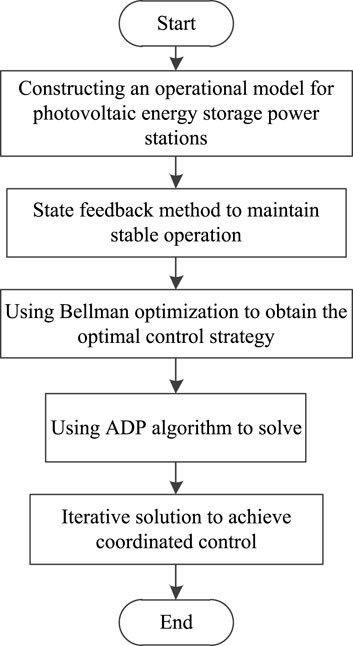
Figure 2. Flow chart of coordinated control for photovoltaic energy storage power stations based on ADP algorithm.
The photovoltaic energy storage power station is set at a random operating point. In the state of linearized continuous operation, the operating model expression of the photovoltaic energy storage power station is as follows:
In formula (7),
The expression of using the state feedback method to maintain the voltage of the photovoltaic energy storage power station in a stable operating state is as follows:
In formula (8),
According to the Bellman optimization principle, the optimal control strategy expression of photovoltaic energy storage power station is obtained as follows:
In formula (9),
In formula (9), the expression for
In formula (10),
The solution of Riccati equation can be obtained by using exact matrix and matrix parameters. The parameter information of photovoltaic energy storage power station cannot be accurately obtained, and the operation of photovoltaic energy storage power station is greatly affected by the environment and temperature, resulting in great fluctuation of the operation state of photovoltaic energy storage power station (Yu et al., 2020). Fully considering the problem that the dynamic information parameters of photovoltaic energy storage power plants cannot be accurately obtained, the coordination control of photovoltaic energy storage power plants is realized by solving formula (10) by the voltage safety optimal control method of ADP.
The ADP algorithm is used to solve formula (9), and the power constraint conditions of the photovoltaic energy storage system are fully considered.
In formula (14),
In formula (15),
Based on the above formula, the expression of
Using ADP algorithm to learn dynamic information online. The steps of iterative solution to realize the coordinated control of photovoltaic energy storage power station are as follows.
(1) Set
(2) formula (13) is used to solve the
(3) Update
(4) Set the number of terations to
(5) The optimal control strategy of coordination control for photovoltaic storage power station is
In the actual operation of a photovoltaic storage power station, the iterative solution time needs to be predetermined before the coordinated control strategy is determined (Meng et al., 2021). In this paper, an 8-min solution process is set up, i.e., the optimal control strategy of voltage safety is updated every 8 min.
4 Case analysis
To validate the efficacy of the proposed ADP-based coordinated control strategy for photovoltaic power stations, we implemented the strategy within a practical photovoltaic facility. Taking into account the unique operational characteristics of the energy storage equipment in such stations, we examined how the strategy responded under diverse operating scenarios. This thorough assessment involved applying the strategy to the coordination and control of the photovoltaic storage power station, and the operational parameters of this system are detailed in Table 2.
Figure 3 shows the change of light intensity during the operation of the photovoltaic energy storage power station.
The photovoltaic power of photovoltaic storage power station is obtained according to the change of illumination intensity. The photovoltaic power statistics of a photovoltaic storage power station are shown in Figure 4.
The experimental results of Figure 3 and Figure 4 show that the output power of the distributed photovoltaic system can be effectively controlled at the maximum power point when the light intensity varies. The experimental results of Figure 3 and Figure 4 show that the proposed strategy can realize the coordinated control of photovoltaic energy storage system with good control performance.
When this strategy is used to coordinate the control of photovoltaic energy storage plant, the change of charge state of the battery is shown in Figure 5.
When this strategy is used to coordinate the control of photovoltaic storage power station, the change of the charge state of the supercapacitor is shown in Figure 6.
As depicted in Figures 5 and Figure 6, the experimental outcomes demonstrate that the charge-state profiles of both storage batteries and supercapacitors in photovoltaic power stations are successfully managed within a stable operational range, thus preventing any occurrence of overcharging or overdischarging. This underscores the exceptional coordination and control capabilities of the implemented strategy, ensuring that the photovoltaic energy storage plant maintains a reliable and consistent operation while enhancing the longevity of the storage system.
In order to verify the performance of the strategy, the node voltage changes of the PV power station during normal charging and discharge are calculated by comparing the methods of (Srilakshmi et al., 2024a; Srilakshmi et al., 2024b). When the bus voltage fluctuates excessively, it will affect the stable operation of photovoltaic power station. The results of voltage variation of each node in the PV power station are shown in Figure 7.
The results of voltage variation of each node in the PV power station are shown in Figure 8.
The experimental results of Figure 7 and Figure 8 show that there are voltage overshoot in several nodes of the feeders when the feeders are charged and discharged normally without this strategy. When using other control methods, there are still more nodes than the upper limit when the energy storage system is charging normally and more nodes than the lower limit when the energy storage system is discharging normally. The node voltage of the feeders can be restored to normal state after the photovoltaic power station is controlled by this strategy. Figure 7 and Figure 8 show that the proposed strategy can ensure the voltage of the PV power station to be stable in a fixed range under normal charging and discharging conditions.
5 Conclusion and future work
5.1 Conclusion
The ADP-based coordination control strategy has been rigorously examined, enabling adaptive optimization of charging and discharging power. Specifically, this strategy addresses the fluctuations in photovoltaic power by optimizing the charge and discharge capabilities of the battery system within photovoltaic power stations. The comprehensive testing has validated that this approach facilitates efficient charging and discharging cycles, enhancing energy storage capacity while preventing potentially damaging overcharging and over discharging. Furthermore, the coordinated control strategy dynamically adjusts the power output of the energy storage system, minimizing operational fluctuations. This ensures that the photovoltaic storage power station maintains stable voltages within an optimal range, extending the lifespan of the storage system and optimizing the voltage distribution across the entire storage power network. Ultimately, this approach also contributes to an improved dissipation level in distributed photovoltaic energy storage plants.
5.2 Future work
This article has the following points for future research directions.
(1) Improvement and optimization of ADP algorithm. Further research the application of ADP algorithm in coordinated control of photovoltaic energy storage power stations, explore the improvement and optimization methods of the algorithm, such as improving the convergence speed of the algorithm and reducing computational complexity. Research and integrate ADP algorithm with other advanced control algorithms, such as reinforcement learning and deep learning, to further improve the performance of control strategies.
(2) Deepening and refining the model. With the advancement of technology and in-depth research, the model of photovoltaic energy storage power stations can be further refined in the future, including considering more influencing factors and more components. Introduce more advanced simulation tools and methods to more accurately simulate the operation of power plants and optimize control strategies.
(3) Innovation and application of energy storage technology. Research the application and performance optimization of these new technologies in photovoltaic energy storage power stations, as well as the capacity configuration and energy management strategies of energy storage systems, in order to improve the utilization and economic benefits of energy storage systems.
Data availability statement
The raw data supporting the conclusion of this article will be made available by the authors, without undue reservation.
Author contributions
SL: Writing–original draft, Writing–review and editing. SS: Writing–original draft, Writing–review and editing. FW: Writing–original draft, Writing–review and editing.
Funding
The author(s) declare that financial support was received for the research, authorship, and/or publication of this article. The study was supported by “Research on the Collaborative Development Strategy of Source Network Load Storage in Luohe Power Supply Area Technical Services (SGHALHOFCJS2200259)”.
Conflict of interest
Authors SL, SS, and FW were employed by State Grid Henan Electric Power Company Luohe Electric Power Supply Company.
Publisher’s note
All claims expressed in this article are solely those of the authors and do not necessarily represent those of their affiliated organizations, or those of the publisher, the editors and the reviewers. Any product that may be evaluated in this article, or claim that may be made by its manufacturer, is not guaranteed or endorsed by the publisher.
References
Bi, Y., Fang, S. R., and Yu, S. Q. (2021). Coordinated control strategy for low frequency oscillations of weak AC grid connected PV systems. J. Electr. Power Sci. Technol. 36 (04), 59–65. doi:10.19781/j.issn.1673-9140.2021.04.008
Cui, H. F., Wang, D. S., Yang, B., Wu, B. F., Zhu, Y. Y., and Zhao, J. J. (2020). Coordinated control strategy of wind-solar-storage power station supporting black start of power grid. Electr. Power Constr. 41 (09), 50–57. doi:10.12204/J.ISSN.1000-7229.2020.09.006
Dong, H. Y., Zhang, H., Chen, Z., Huang, R., and Ding, K. (2021b). Research on reactive stratification coordination optimization control strategy of csp-pv hybrid system. Acta Energiae Solaris Sin. 42 (06), 162–169. doi:10.19912/j.0254-0096.tynxb.2019-0130
Dong, X. W., Pei, C. C., Deng, W., Li, B., and Dai, B. (2021a). Research on control strategy of distributed energy storage system in distribution network with new energy. Electr. Power Constr. 42 (05), 81–89. doi:10.12204/j.issn.1000-7229.2021.05.009
Liu, S., Li, X. C., and Chen, D. Y. (2020). Nonlinear coordinated control strategy of large-scale photovoltaic power station with energy storage and synchronous generator excitation. Electr. Power Autom. Equip. 40 (05), 92–100. doi:10.16081/j.epae.202003028
Lu, J. L., Zhang, W., Zhang, X. G., He, T. X., and Wen, R. T. (2021). Coordinated control strategy for photovoltaic micro-grid system with hybrid energy-storage. Proc. CSU-EPSA 33 (08), 102–108. doi:10.19635/j.cnki.csu-epsa.000551
Meng, G. J., Zhao, Y., Wu, T., Ma, F. Y., and Zhang, F. (2021). Research on coordination control strategy optimization of large-scale energy storage power station participating in automatic generation control of power system. Renew. Energy Resour. 39 (02), 270–277. doi:10.3969/j.issn.1671-5292.2021.02.020
Srilakshmi, K., Gaddameedhi, S., Borra, S., Balachandran, P. K., Reddy, G. P., Palanivelu, A., et al. (2024b). Optimal design of solar/wind/battery and EV fed UPQC for power quality and power Flow management using enhanced Most valuable player algorithm. Front. energy Res. 11 (11), 1–26. doi:10.3389/fenrg.2023.1342085
Srilakshmi, K., Rao, G. S., Swarnasri, K., Inkollu, S. R., Kondreddi, K., Balachandran, P. K., et al. (2024c). Optimization of ANFIS controller for solar/battery sources fed UPQC using an hybrid algorithm. Electr. Eng. 3 (106), 39–46. doi:10.1007/s00202-023-02185-8
Srilakshmi, K., Santosh, D., Ramadevi, A., Balachandran, P. K., Reddy, G. P., Palanivelu, A., et al. (2024a). Development of renewable energy fed three-level hybrid active filter for EV charging station load using Jaya grey wolf optimization. Sci. Rep. 1 (14), 4429–4523. doi:10.1038/s41598-024-54550-7
Tang, W., Li, T. R., Zhang, L., Cai, Y. X., Zhang, B., and Wang, Z. Q. (2020). Coordinated control of photovoltaic and energy storage system in low-voltage distribution networks based on three-phase four-wire optimal power Flow. Automation Electr. Power Syst. 44 (12), 31–40. doi:10.7500/AEPS20190609004
Wang, Z., Zhang, J., Jia, C. R., Peng, Q., and Sun, Y. L. (2021). Coordinated control strategy of photovoltaic-energy storage micro-grid with VSG and APF based on Q-learning algorithm. Renew. Energy Resour. 39 (07), 982–987. doi:10.3969/j.issn.1671-5292.2021.07.020
Xiao, A. N., Zhang, W. X., Zhang, C., Deng, Z. Q., Zheng, Y. J., and Zhu, D. F. (2020). Voltage security optimal control strategy of distribution network with PVs and ESs under"Source-Grid-Load"interaction. J. Electr. Power Sci. Technol. 35 (02), 120–127.
Yan, C. Y., and Fan, Y. F. (2020). Photovoltaic-dual units energy storage system cooperative smoothing power fluctuation control strategy in different scenes. Renew. Energy Resour. 38 (02), 164–171.
Yu, Z. P., Tang, Y., Dai, J. F., and Yi, J. (2020). Voltage/var control strategy of PV plant based on adaptive adjustment of active power. Power Syst. Technol. 44 (05), 1900–1907. doi:10.13335/j.1000-3673.pst.2018.2647
Keywords: adaptive dynamic programming, photovoltaic energy storage power station, coordinated control strategy, energy storage, environmental problem
Citation: Liang S, Sun S and Wang F (2024) Coordinated control strategy of photovoltaic energy storage power station based on adaptive dynamic programming. Front. Energy Res. 12:1419387. doi: 10.3389/fenrg.2024.1419387
Received: 18 April 2024; Accepted: 12 June 2024;
Published: 17 July 2024.
Edited by:
Sandip K. Saha, Indian Institute of Technology Bombay, IndiaReviewed by:
Shuailong Dai, University of Birmingham, United KingdomPraveen Kumar Balachandran, Vardhaman College of Engineering, India
Copyright © 2024 Liang, Sun and Wang. This is an open-access article distributed under the terms of the Creative Commons Attribution License (CC BY). The use, distribution or reproduction in other forums is permitted, provided the original author(s) and the copyright owner(s) are credited and that the original publication in this journal is cited, in accordance with accepted academic practice. No use, distribution or reproduction is permitted which does not comply with these terms.
*Correspondence: Sipei Sun, c2hhbnRvbmcwMDQwMDQzNzQyQDE2My5jb20=
 Shuhao Liang
Shuhao Liang Sipei Sun
Sipei Sun